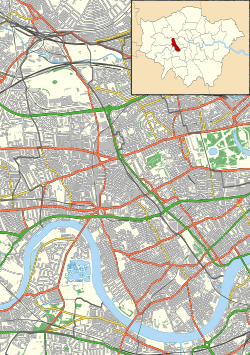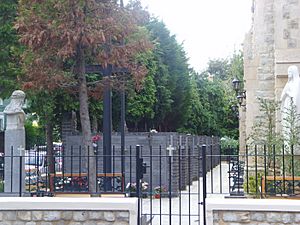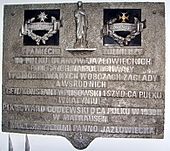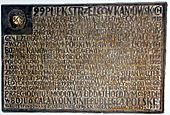St Andrew Bobola Church, Hammersmith facts for kids
Quick facts for kids St Andrew's Polish RC Church |
|
|---|---|
| St Andrew Bobola Polish Roman Catholic Church | |
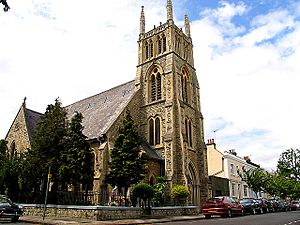
St Andrew Bobola Church in Leysfield Road
|
|
| 51°30′03″N 0°14′16″W / 51.5009°N 0.2378°W | |
| Location | 1, Leysfield Road Shepherd's Bush, W 12 London Borough of Hammersmith and Fulham |
| Country | United Kingdom |
| Denomination | Roman Catholic |
| Website | https://bobola.church/en/ |
| History | |
| Former name(s) | St Andrew's Presbyterian Church |
| Status | Active |
| Founded | 1869 |
| Founder(s) | Divisional general Archbishop Józef Gawlina in 1962 |
| Dedication | St. Andrew Bobola |
| Architecture | |
| Functional status | Parish Church |
| Architect(s) | Edmund Woodthorpe |
| Style | Gothic Revival |
| Groundbreaking | 1869 |
| Completed | 1870 |
| Closed | 1960 |
| Administration | |
| Parish | West London Polish Community |
| Archdiocese | Westminster |
| Province | Polish Catholic Mission |
The St Andrew Bobola Church in Hammersmith, also known as the Polish Church in Shepherd's Bush, is a Roman Catholic church. It serves the Polish community living in West London. The church building was designed in the Gothic Revival style by Edmund Woodthorpe. You can find it at 1 Leysfield Road, near Ravenscourt Park.
Contents
A Look at the Church's History
The church building was first started in 1869. It was built for the Scottish Presbyterian community and was named after St Andrew the Apostle. He is the patron saint of Scotland. The architect, Edmund Woodthorpe, designed it in the popular Neo Gothic style. The church was officially opened in 1870.
Over time, fewer people attended the Presbyterian church. Around 1960, it was decided to combine it with another church. The church leaders then looked for another Christian group to buy the building. In 1961, the Polish Catholic Mission in the United Kingdom bought the church. They paid for it with a loan, which was later paid off by donations from people who believed in their mission.
Becoming a Polish Catholic Church
The church was rededicated in 1962. This time, it was named after a different St Andrew. It became part of the Archdiocese of Westminster. This church was only the second Catholic church in London to serve the Polish community. The very first Polish church in London was in Islington. It was dedicated to Our Lady of Częstochowa and St Casimir. That church was the first building owned by Poles for religious use in the British Isles. It opened on October 30, 1930.
The people who first attended the St Andrew Bobola Church in West London were often survivors of difficult times. Many had lived through the challenges of Siberia during and after World War II. The church also became a special place for thousands of Polish veterans. These brave soldiers had fought with the Allies but could not return to their homeland. This was because of an agreement called the Yalta Agreement.
From 1961 to 1979, Father Kazimierz Sołowiej was the parish priest. He was in charge of making the building new again. Even though the outside of the church looks simple, the inside was made "daringly modern". Polish artists and craftspeople, led by designer Aleksander Klecki, worked on it. The interior now has many beautiful items inspired by Polish art and religious traditions.
To the left of the main entrance, there is a special Lady chapel. It is dedicated to Our Lady of Kozielsk. The original image of Our Lady of Kozielsk in Poland was honored by Pope John Paul II in 1997.
The church is seen as an important building for its architecture. It is listed with the Hammersmith and Fulham Historic Buildings Group. In 2008, the priest received an award for taking good care of the church.
The Smolensk Air Disaster
The church and the entire Polish community in West London were very sad in 2010. Their fourth parish priest, Father Bronisław Gostomski, died in the Smolensk air disaster on April 10, 2010. He was on a Polish Air Force plane, a Tupolev Tu-154. The plane was carrying many important Polish people. They were going to visit the Katyn site for the 70th anniversary of a tragic event. The plane crashed near the Russian city of Smolensk. No one survived, and the reason for the crash is still not fully clear.
Remembering Important Events
During the time of Communist Poland, it was not allowed to remember Poland's struggles against the USSR. So, the only way to honor those who fought was to create memorials in the Free World. This is why there are over 80 memorial plaques inside the church.
The first plaque was put up on November 24, 1963. It was designed by Stefan Jan Baran and honored the Lwow Eaglets. On April 12, 1964, a plaque for General Walerian Czuma was unveiled. Other plaques remember the many Polish Army groups that defended Poland in different wars. These include:
- 14th Jazlowiec Uhlan Regiment (for Brigadier General Konstanty Plisowski and Colonel Edward Godlewski)
- 10 Pułk Strzelców Konnych (II RP) (10th Mounted Rifle Division)
- 1st Krechowce Uhlan Regiment
- 68 Pułk Piechoty (II RP) (68th Infantry Division)
- 69 Pułk Piechoty (II RP) (69th Infantry Division)
- 70 Pułk Piechoty (II RP) (70th Infantry Division)
- 17th Infantry Division (Poland)
- 17 Pułk Artylerii Lekkiej (17th Light Artillery Division)
- 22 Pułk Piechoty (II RP) (22nd Infantry Division)
- 29 Pułk Strzelców Kaniowskich (29th Kaniów Rifle Division)
- 1st Grenadier Division (Poland)
- 2nd Rifle Division (Poland)
- 16 Lwowski Batalion Strzelców (16th Lwów Rifle Division)
- 7 Pułk Artylerii Przeciwpancernej (7th Anti-Tank Artillery Division)
- 8 Batalion Strzelców Brabanckich (8th Battalion of Brabant Rifles)
- 9 Batalion Strzelców Flandryjskich (9th Battalion of Flanders Rifles)
- 5th Kresowa Infantry Division
- Pułk Ułanów Karpackich (Carpathian Uhlan Division)
On May 29, 1983, memorials were unveiled for the battalions of the Polish Corps of Cadets. These included Cadet Corps Numbers 1, 2, and 3.
On April 23, 1978, soil from the Katyn massacre site in Soviet-Russia was brought to the church. It was placed inside a wall to remember the 28,000 Polish Army Reserve officers. These officers, from all backgrounds, were killed in 1940 by order of Stalin. This important act was made possible by Captain Zygmunt Godyń, a cavalry officer.
A Place for Ashes: The Columbarium
In the small garden around the church, there is a columbarium. This is a special place where the ashes of over 1300 people are kept. The idea for this "crypt," located to the left of the main entrance, came from Maria Leśniak.
Commemorative Gallery


